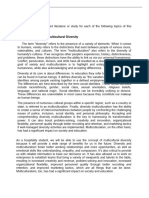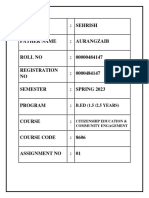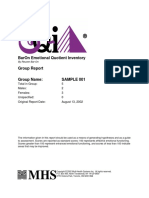Course Objectives
Course Objectives
Uploaded by
RazwanjiCopyright:
Available Formats
Course Objectives
Course Objectives
Uploaded by
RazwanjiOriginal Title
Copyright
Available Formats
Share this document
Did you find this document useful?
Is this content inappropriate?
Copyright:
Available Formats
Course Objectives
Course Objectives
Uploaded by
RazwanjiCopyright:
Available Formats
The existence of diversity among groups of people means that there are likely to be differences in
both culture and structure, and these will have an effect on perceptions, feelings, and attitudes.
Culture includes, among other things, language, style, custom, conventions, and normative
behavior. Structure means the relationships that you have with other people, which is often
defined in terms of class, status, and power. People bring with them into organizations the
patterns of behavior and thinking, the networks, the social pressures, the habits, and strategies of
action which they learned before joining the organization. Further, people are shaped by the
perceptions, attitudes, and behaviors of others in regard to them. One's social identity is
interactive with other people's social categorization and is embedded within social structures.
Although many organizations in the past have tried to homogenize behavior and attitudes by
developing their own organizational cultures, the reality in most organizations is the existence of
distinct subcultures and microcultures, as people with different social identities try to negotiate or
maneuver for advantage, often in competition with others.
Diversity creates positive outcomes for organizations when differences among people lead not
only to a larger pool of qualified workers, but also to more creative problem solving, more
productive use of human resources, and better understanding of markets and competitors.
Negative outcomes, however, can result if diversity leads to misunderstanding, distorted
communication, destructive competition, political maneuvering, favoritism, discrimination, and
intolerance. Which set of outcomes is most likely depends on the extent to which people welcome
diversity, value it, and know how to manage it effectively.
There are many dimensions on which people
meaningfully differ: by race, ethnicity, gender, class, sexual orientation, physical abilities, age
and generation, region, industry, occupatio n, function, department, project, education, and so on.
Important differences are those that have consequential effects for your experiences on the job,
your career, and your life opportunities and rewards. Knowing how to successfully manage in
diverse business situations will undoubtedly have effects on both the corporate bottom line and on
your own career prospects.
Course Objectives:
1. To understand yourself in relationship to the people around you, i.e. your own place
within cultures, subcultures, demographic subgroups, and social structure, and how these
characteristics affect how you act and think.
2. To understand the people around you (your bosses, peers, subordinates, people in other
parts of your and other organizations, customers and competitors), i.e., their participation
in cultures, subcultures, demographic subgroups, and social structure and how these
characteristics affect how they act and think.
3. To understand the processes that lead to the usual reactions to difference, namely, anger,
fear, and often hatred, and to learn to respond positively.
4. To understand the mechanisms that maintain perceptions of difference and which make
difference consequential in our lives.
5. To understand how diversity management relates to strategic changes in organizations.
6. To practice management skills that improve outcomes as the work force, organizations,
and the business environment become more diverse.
You might also like
- Principles Your Guided Journal - Ray DalioDocument263 pagesPrinciples Your Guided Journal - Ray DalioFakhri Hafy67% (3)
- The Kamitic Tree of LifeDocument7 pagesThe Kamitic Tree of LifeLawrence W Spearman100% (20)
- Reward Dominance and Prefrontal Dysfunction TheoriesDocument20 pagesReward Dominance and Prefrontal Dysfunction TheoriesDave Futalan50% (2)
- CHCDIV003 Online Learning AssessmentDocument6 pagesCHCDIV003 Online Learning Assessmentuniquely common100% (1)
- Diversity and EthicsDocument4 pagesDiversity and EthicsUsman FazalNo ratings yet
- Workforce DiversityDocument22 pagesWorkforce DiversityAnkita Saxena50% (2)
- lecturer note handouteDocument67 pageslecturer note handouteZeleke GetinetNo ratings yet
- Organizational Behavior Tools For Success 2nd Edition Phillips Solutions ManualDocument25 pagesOrganizational Behavior Tools For Success 2nd Edition Phillips Solutions Manuala622706329No ratings yet
- Diass SSLM Q1 W6Document8 pagesDiass SSLM Q1 W6Bonie ConjeNo ratings yet
- Social WorkDocument6 pagesSocial Workmagorongaanopa02No ratings yet
- Organizational Behavior and The Wider CultureDocument41 pagesOrganizational Behavior and The Wider Culturejenicejoy0% (2)
- Chapter #3Document4 pagesChapter #3hamid farooqNo ratings yet
- Socio-Cultural Environment, MBAIVDocument4 pagesSocio-Cultural Environment, MBAIVnehakalra2455No ratings yet
- DIASS Q2 Module6Document16 pagesDIASS Q2 Module6Marylen LincalloNo ratings yet
- Defining Diversity:: 1. Power TheoryDocument4 pagesDefining Diversity:: 1. Power TheoryEthan ChristopherNo ratings yet
- Handling Diversity in Organizational BehaviorDocument5 pagesHandling Diversity in Organizational BehaviorEthan ChristopherNo ratings yet
- Introduction of SM ProjectDocument3 pagesIntroduction of SM ProjectaddityasurveNo ratings yet
- Multi ResearchDocument11 pagesMulti Researchrona032003No ratings yet
- Understand_Social_Identity_to_Lead_in_a_Changing_World_from_Center_for_Creative_LeadershipDocument6 pagesUnderstand_Social_Identity_to_Lead_in_a_Changing_World_from_Center_for_Creative_LeadershipAiibe CNo ratings yet
- CultureDocument41 pagesCulture夜晨曦No ratings yet
- Lesson 7Document6 pagesLesson 7muffinfluffy78No ratings yet
- Concepts On Organizational Behavior, Culture, and Diversity: Major Behavioral Science DisciplinesDocument3 pagesConcepts On Organizational Behavior, Culture, and Diversity: Major Behavioral Science DisciplinesNhiica MhaeNo ratings yet
- Globalisation&OBDocument2 pagesGlobalisation&OBVeena UllagaddiNo ratings yet
- RRLsDocument6 pagesRRLsRobot RobotNo ratings yet
- Social and Cultural World Unit Booklets 1-3Document71 pagesSocial and Cultural World Unit Booklets 1-3Leah WanNo ratings yet
- Name: Muhammad Sadiq Aftab Batch: 2011-12 Roll No: CE-093 Department: Civil Engineering (Construction Management) Course: Organizational SystemDocument6 pagesName: Muhammad Sadiq Aftab Batch: 2011-12 Roll No: CE-093 Department: Civil Engineering (Construction Management) Course: Organizational SystemMuhammad Sadiq AftabNo ratings yet
- Week 5 Notes - DIVERSITY IN THE WORKPLACE 1Document20 pagesWeek 5 Notes - DIVERSITY IN THE WORKPLACE 1Malika WilliamsNo ratings yet
- Communication in Professional Life by Manal GuptaDocument7 pagesCommunication in Professional Life by Manal GuptamanalNo ratings yet
- What Are Examples of Sociocultural FactorsDocument3 pagesWhat Are Examples of Sociocultural Factorsarchitectfemil6663100% (1)
- Cultural Diversity in The Health Care Workforce: By. Ns. Wulan PurnamaDocument21 pagesCultural Diversity in The Health Care Workforce: By. Ns. Wulan Purnamaeka peranduwinataNo ratings yet
- Implications of CrossDocument36 pagesImplications of Crossanisha jaiswalNo ratings yet
- Sociology ReportDocument13 pagesSociology ReportSadia SaleemNo ratings yet
- Cultural Mindset ComponentsDocument3 pagesCultural Mindset ComponentsRio AlbaricoNo ratings yet
- Business CultureDocument2 pagesBusiness CulturesurayaNo ratings yet
- Unit-1 MHR-106 Cultural VariablesDocument28 pagesUnit-1 MHR-106 Cultural Variableskekhusezo100% (1)
- Related: Managing Diversity (MD)Document5 pagesRelated: Managing Diversity (MD)anishtomanishNo ratings yet
- Clientele and Audiences in Social WorkDocument15 pagesClientele and Audiences in Social Workriselle alfilerNo ratings yet
- 8606-1st AssignmentDocument24 pages8606-1st AssignmentMohsin ArshadNo ratings yet
- Social Networking m2Document32 pagesSocial Networking m2Navya GulatiNo ratings yet
- SS Elec 6 Oral RecitationDocument6 pagesSS Elec 6 Oral RecitationJollibeth GanteNo ratings yet
- Discussion Assignment 1Document2 pagesDiscussion Assignment 1Djahan Rana100% (1)
- Lesson 7 Clientes in Social WorkDocument5 pagesLesson 7 Clientes in Social Workcindy juntongNo ratings yet
- Mulungushi University: School of Busness StudiesDocument6 pagesMulungushi University: School of Busness StudieskingNo ratings yet
- 9 CSWE Competencies With Suggested Learning Activities 8.17.17Document6 pages9 CSWE Competencies With Suggested Learning Activities 8.17.17Mutati TNo ratings yet
- Effective Cross-Cultural Communication For International BusinessDocument8 pagesEffective Cross-Cultural Communication For International BusinessHunza NadeemNo ratings yet
- CPHRM SummaryDocument51 pagesCPHRM SummaryDaan Spijker100% (1)
- Cross Cultural MCDocument12 pagesCross Cultural MCask123.grindeNo ratings yet
- Workplace DiversityDocument6 pagesWorkplace Diversityhailheal9No ratings yet
- Mangayao, Janica Mae Gomez - Maed101Document29 pagesMangayao, Janica Mae Gomez - Maed101Janica Mae MangayaoNo ratings yet
- Human & Cultural VariablesDocument5 pagesHuman & Cultural VariablesAbhi JainNo ratings yet
- BEHAVIORAL SCIENCE - 2024 SpskacDocument23 pagesBEHAVIORAL SCIENCE - 2024 SpskacAbhishek ChakrabortyNo ratings yet
- Organizational Behavior Assignment OnDocument28 pagesOrganizational Behavior Assignment OnSagar Gupta50% (2)
- Cultural CompetencyDocument17 pagesCultural CompetencyRaja Chinna Malakonda RayuduNo ratings yet
- Ques. External Influences On CB: Consumer Behaviour Is The Study ofDocument8 pagesQues. External Influences On CB: Consumer Behaviour Is The Study ofIñnøcent ManinderNo ratings yet
- Cause and Effect DraftDocument5 pagesCause and Effect DraftNoreen LagmanNo ratings yet
- MAN201 - Class 4 - Personality + Values - Diversity in OrganizationsDocument13 pagesMAN201 - Class 4 - Personality + Values - Diversity in OrganizationsNgoc Nguyen Thi MinhNo ratings yet
- Unit 3 CHPT 6 Socio Cultural Env Social Audit CSRDocument35 pagesUnit 3 CHPT 6 Socio Cultural Env Social Audit CSRMilan JainNo ratings yet
- Workforce Diversity in India at IBMDocument43 pagesWorkforce Diversity in India at IBMAbhilash GargNo ratings yet
- How Does A Diverse Customer Service Team Impact Upon An Originations Employees and Customer Satisfaction? (Writer Name) (Institute Name)Document14 pagesHow Does A Diverse Customer Service Team Impact Upon An Originations Employees and Customer Satisfaction? (Writer Name) (Institute Name)maria_meNo ratings yet
- Organizational Behavior Tools For Success 2nd Edition Phillips Gully Solution ManualDocument26 pagesOrganizational Behavior Tools For Success 2nd Edition Phillips Gully Solution Manualwilliam100% (41)
- Module 5 and 6Document14 pagesModule 5 and 6Jhener Nonesa100% (3)
- Foundations And New Frontiers In Diversity, Equity, And InclusionFrom EverandFoundations And New Frontiers In Diversity, Equity, And InclusionNo ratings yet
- Unraveling Human Nature: Insights from History to TomorrowFrom EverandUnraveling Human Nature: Insights from History to TomorrowNo ratings yet
- 9 - (M9AL-IIa-1a) Inverse VariationDocument4 pages9 - (M9AL-IIa-1a) Inverse VariationMariel Pastolero100% (1)
- The Effect of United States' Politics On AltruismDocument17 pagesThe Effect of United States' Politics On AltruismdwnmstrsnNo ratings yet
- ShadowDocument2 pagesShadowDanear Jabbar AbdulkareemNo ratings yet
- Moral Vs Non Moral StandardsDocument38 pagesMoral Vs Non Moral StandardsLeonel DolendoNo ratings yet
- Lesson Plan 5-CombinedDocument21 pagesLesson Plan 5-Combinedapi-663783105No ratings yet
- Fulfilling My Dreams in LifeDocument1 pageFulfilling My Dreams in LifedinaamorsininingNo ratings yet
- 2004 - Robert Mazano. - The Importance of Background Knowledge. Washington, DC The National Center For Education Statistics.Document140 pages2004 - Robert Mazano. - The Importance of Background Knowledge. Washington, DC The National Center For Education Statistics.Ha Linh DuongNo ratings yet
- Hkcox1a-Hkcox1a Reader (2023)Document76 pagesHkcox1a-Hkcox1a Reader (2023)Xoliswa MabasoNo ratings yet
- Đề thi Vào 10 Chuyên Anh Phú Yên 2020-2021Document6 pagesĐề thi Vào 10 Chuyên Anh Phú Yên 2020-2021Trang Nguyễn100% (1)
- Emotions and FeelingsDocument10 pagesEmotions and FeelingsNiqito PardoNo ratings yet
- Bar On Emotional Quotient InventoryDocument26 pagesBar On Emotional Quotient InventoryVANSHAJ JHA100% (3)
- Reasons To Get A DogDocument1 pageReasons To Get A DogKimNo ratings yet
- Week 1 - Introduction To Consumer Behaviour - TRI 3 2022Document80 pagesWeek 1 - Introduction To Consumer Behaviour - TRI 3 2022Onur SerbestNo ratings yet
- Lee Kim2019 - Article - APeer To peerP2PPlatformBusine PDFDocument23 pagesLee Kim2019 - Article - APeer To peerP2PPlatformBusine PDFIgor de Castro ChieregatoNo ratings yet
- BaronKenny 86Document11 pagesBaronKenny 86suruchisinghjan22No ratings yet
- Forecast Speaking Quý 3 2024Document28 pagesForecast Speaking Quý 3 2024Trần ChiNo ratings yet
- Mercury in 1st HouseDocument11 pagesMercury in 1st HouseOtilija BalevičiūtėNo ratings yet
- He Who Fights With Monsters, 703 - Primary PurposeDocument8 pagesHe Who Fights With Monsters, 703 - Primary Purposehughman2956No ratings yet
- Therapeutic ReviewerDocument2 pagesTherapeutic ReviewerGrachiella Janen LaroyaNo ratings yet
- КТП 11 Сынып Ағылшын Тілі Айтмұхан АнарDocument11 pagesКТП 11 Сынып Ағылшын Тілі Айтмұхан Анарmoldyr785No ratings yet
- Acceptance and Commitment Therapy (ACT) As A Career Counseling StrategyDocument17 pagesAcceptance and Commitment Therapy (ACT) As A Career Counseling Strategydavid.settembrinoNo ratings yet
- Empowerment Empowerment EmpowermentDocument27 pagesEmpowerment Empowerment EmpowermentVIRGILIO JR FABINo ratings yet
- CANDOR (The Honest) : Faction ManifestoDocument4 pagesCANDOR (The Honest) : Faction ManifestoJohnny JohnnieeNo ratings yet
- Department of Education: Topic: Time Frame: Date: I. OutcomesDocument3 pagesDepartment of Education: Topic: Time Frame: Date: I. Outcomesglenn paul catotoNo ratings yet
- Module 2 Discipline of CounselingDocument20 pagesModule 2 Discipline of CounselingRaiza Cabrera100% (2)
- Principles of Management and Organisational BehaviourDocument70 pagesPrinciples of Management and Organisational BehaviourJahnavi ChakravartiNo ratings yet
- Fundamentals of Martial Arts (Criminology Departmentss)Document2 pagesFundamentals of Martial Arts (Criminology Departmentss)Park WangjaNo ratings yet

























































































